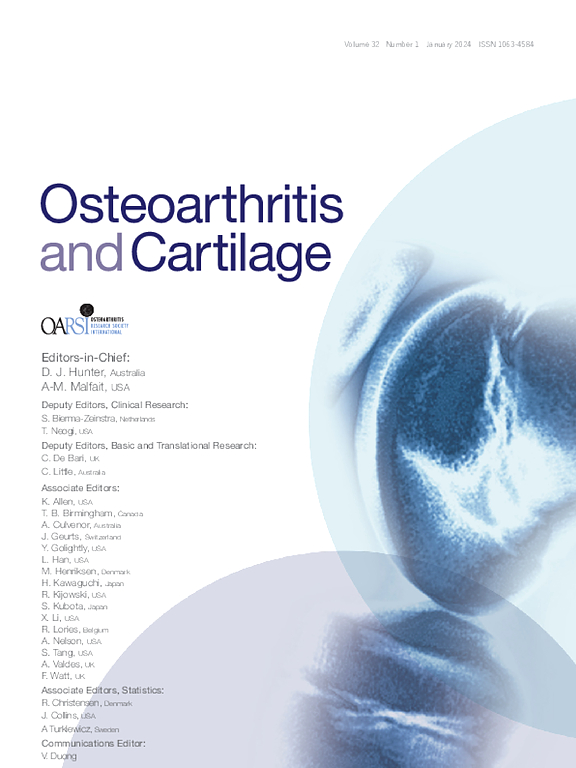DXA images vs. pelvic radiographs: Reliability of hip morphology measurements
IF 9
2区 医学
Q1 ORTHOPEDICS
引用次数: 0
Abstract
Objective
Dual-energy x-ray absorptiometry (DXA) images are increasingly used to study hip morphology. Whether hip morphology measurements are consistent between DXA images and radiographs is unknown. Therefore, we investigated the agreement and reliability of the measurements performed on DXA images and radiographs.
Design
We included participants from the Rotterdam study, a population-based cohort study, who received a hip DXA image and pelvic radiograph on the same day. The acetabular depth-width ratio (ADR), modified acetabular index (mAI), alpha angle (AA), Wiberg and lateral center edge angle (WCEA, LCEA), extrusion index (EI) and triangular index ratio (TIR) were automatically determined on both imaging modalities. The intraobserver and intermethod agreement were studied using Bland-Altman methods, and the reliability was assessed using intraclass correlation coefficients (ICC). Secondly, the diagnostic agreement regarding dysplasia, cam, and pincer morphology was assessed using percent agreement and Cohen’s kappa.
Results
A total of 750 hips from 411 individuals, median age 67.3 years (range 52.2 – 90.6), 45.5% male, were included. The following intermethod ICCs (95% CI) were obtained: ADR 0.85 (0.74–0.91), mAI 0.75 (0.52–0.85), AA 0.72 (0.68–0.75), WCEA 0.81 (0.74–0.85), LCEA 0.93 (0.91–0.94), EI 0.88 (0.84–0.91), and TIR 0.81 (0.79–0.84). We found comparable intraobserver ICCs for each morphological measurement.
Conclusion
DXA images and pelvic radiographs could both reliably be used to study hip morphology. Due to the lower radiation burden, DXA images could be an excellent alternative to pelvic radiographs for research purposes.
DXA 图像与骨盆 X 光片:髋关节形态测量的可靠性。
目的:双能 X 射线吸收测量(DXA)图像越来越多地被用于研究髋关节形态。DXA图像和X光片之间的髋关节形态测量结果是否一致尚不清楚。因此,我们研究了 DXA 图像和射线照片测量结果的一致性和可靠性:设计:我们纳入了鹿特丹研究(一项基于人群的队列研究)的参与者,他们在同一天接受了髋关节 DXA 图像和骨盆X光片检查。两种成像模式均自动测定髋臼深宽比(ADR)、改良髋臼指数(mAI)、α角(AA)、Wiberg 和外侧中心边缘角(WCEA、LCEA)、挤压指数(EI)和三角指数比(TIR)。采用 Bland-Altman 方法研究了观察者内部和方法间的一致性,并采用类内相关系数(ICC)评估了可靠性。其次,使用一致性百分比和科恩卡帕评估了有关发育不良、凸轮和钳形形态的诊断一致性:结果:共纳入 411 人的 750 个髋关节,中位年龄为 67.3 岁(52.2 - 90.6 岁),45.5% 为男性。获得了以下方法间 ICCs(95% CI):ADR 0.85 (0.74-0.91)、mAI 0.75 (0.52-0.85)、AA 0.72 (0.68-0.75)、WCEA 0.81 (0.74-0.85)、LCEA 0.93 (0.91-0.94)、EI 0.88 (0.84-0.91) 和 TIR 0.81 (0.79-0.84)。我们发现每种形态学测量的观察者内部 ICC 都相当:结论:DXA 图像和骨盆X光片都能可靠地用于研究髋关节形态。结论:DXA 图像和骨盆X光片都能可靠地用于研究髋关节形态。由于辐射负荷较低,DXA 图像在研究中可以很好地替代骨盆X光片。
本文章由计算机程序翻译,如有差异,请以英文原文为准。
求助全文
约1分钟内获得全文
求助全文
来源期刊

Osteoarthritis and Cartilage
医学-风湿病学
CiteScore
11.70
自引率
7.10%
发文量
802
审稿时长
52 days
期刊介绍:
Osteoarthritis and Cartilage is the official journal of the Osteoarthritis Research Society International.
It is an international, multidisciplinary journal that disseminates information for the many kinds of specialists and practitioners concerned with osteoarthritis.
 求助内容:
求助内容: 应助结果提醒方式:
应助结果提醒方式:


